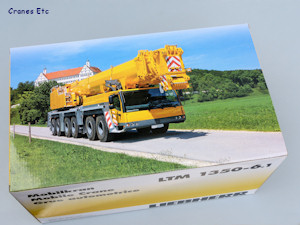 |
| The box.
|
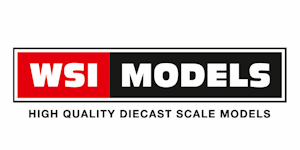 |
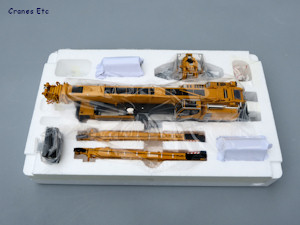 |
| Bottom
tray. |
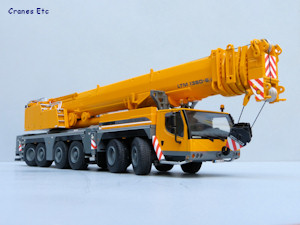 |
| Nice
detailing on the boom. |
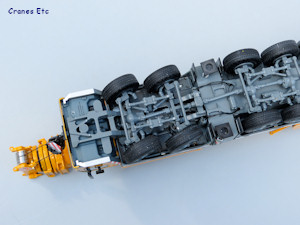 |
| Excellent
chassis detail. |
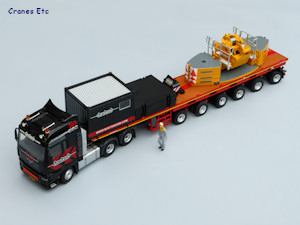 |
| Ballast
tray, hook and spreader plates as a load.
|
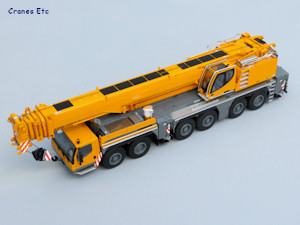 |
| Realistic
overall profile. |
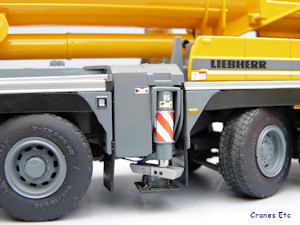 |
| Tiny
graphics on the outriggers. Main ram jacket is
metal. |
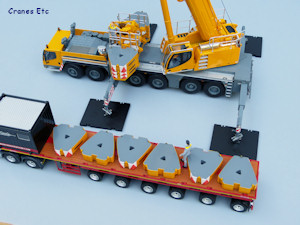 |
| Self
ballasting. |
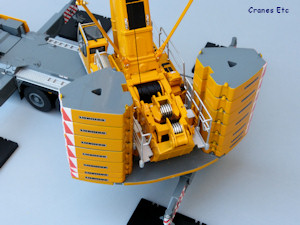 |
| Luffing
gear for a fly jib is included. |
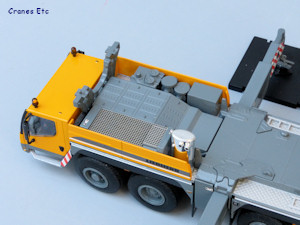 |
| Detail
behind the cab. |
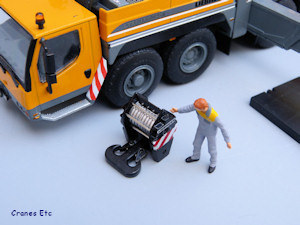 |
| Large hook
is included. |
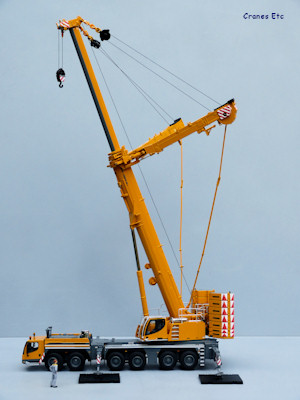 |
| Erect and
ready. |
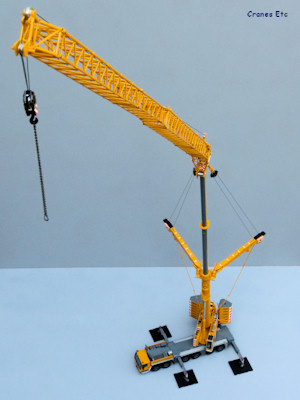 |
| At the
maximum angle. |
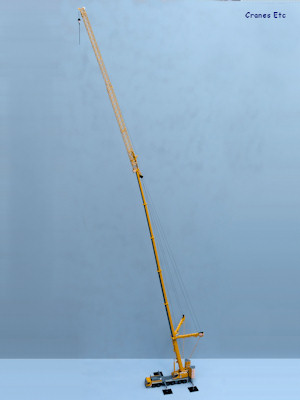 |
| Maximum
height - around 2.3m. |
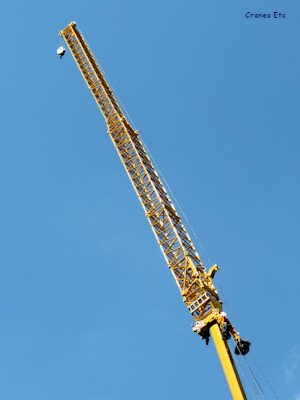 |
| Overall
profile of the fixed jib is good. |
|
 Comment on this model. Comment on this model.
The Liebherr 1350-6.1 mobile crane has a maximum capacity
of 350 tonnes at 3m radius. It has a maximum hook
height of 134m.
Packaging
The model comes in the standard Liebherr box design with
the model held within two separate expanded polystyrene trays
with lids.
There were
no missing parts on the review model.
There were a
number of defects however, none particularly serious. Two of the
axles had seized steering as a result of poor gluing and these were released by the use of careful
but strong force. A handrail section had a bent
post which was eased back into position. The
casting of the over-cab support for the Y-Guy assembly
was incorrect on one side. A loose part on the boom was
re-glued. One of the guy rod rivets was loose and
parted. The angle adjustment on the fixed jib was
seized because of over-tight rivets and had to be prised
open carefully. One of the tools used for fixing brass
bolts was poorly cast and unusable but a second is
included is included with the fixed jib.
There is no information about the real crane,
but the model has a diagrammatic instruction manual.
It is good as far as it goes but there is no reeving
information and as there are a number of small parts an
inventory of pieces would have been very helpful.
Detail
The chassis is highly detailed and it has fully
replicated transmission and suspension systems which
look authentic.
It also has hosing which runs between various small
tanks and the engine area is interesting because the
drive transfer from the gearbox is visible as is the
cooling fan.
The tyres are very good with a fine
tread pattern, and Michelin and the tyre details are moulded
in the sidewalls. The wheels are really good too
with different hubs for driven and non-driven axles.
The driving cab has a tiny loop for hitching the
hook whilst travelling, the door steps are textured
and the handles have realistic inserts. Door mirrors, windscreen wipers
and beacon lights complete the external detail and it is
nice that there are number plates even on a generic
model. Inside the cab the seats have Liebherr printed
on the
backs.
Behind the driving
cab the engine area is well detailed in metal and
plastic, and there is a fine mesh grille. The
plastic chrome exhaust includes realistic holes in the
pipes.
Black replica rubber skirts sit above each pair of wheels.
The outriggers are really good. The pads have a working pinning
mechanism which allows the pads to be fixed in an offset
way so they are within the footprint of the crane when the
outrigger beams are retracted and this has been enhanced
with locking bars which keep the pads under the crane
neatly.
The pistons are smooth with the screw mechanism being
internal so they look realistic and tiny graphics add to
the realism. Large metal spreader plates with
useable lifting points are also included with the model.
At the rear of the carrier there is a useable small
towing hitch and the detailing of the lights is very
good.
The crane cab has metal grab rails with window wipers,
and the interior detail is good. There is a good
quality chrome exhaust and small graphics enhance the
detailing around the body. Two sets of metal
handrails are supplied - one for when the crane is in
transport mode and the other for when it is working.
The counterweight tray has useable lifting points and
the second hoist gear is permanently attached including
ready-reeved gear for a luffing fly jib. The whole
part looks interesting. The counterweight blocks
accurately comprise a full configuration of 140 tonnes
and each block is nicely formed with sharp graphics.
The only thing missing is a lifting bar to enable the
blocks to be posed being lifted.
The main boom ram is an excellent metal part and sets a
standard for this component. Detailing on the boom
includes a couple of spooling drums and with casting details and small graphics it looks
realistic. The inner telescope sections have a
realistic profile with thin walls and are probably aluminium. At the boom head the pulleys are metal
although yellow rather than silver would have looked
closer to the real crane.
An additional part is supplied which appears to attach
on the front of the boom head as if to provide for a
single line hook. However the part had no pulley
or other obvious function.
The Y-Guy system for the telescopic boom comprises two
separate frames. They are metal except for the
hydraulic cylinder jackets and they are detailed parts.
Useable lifting eyes are included as are foldable
support stands. The guy rods are metal although
some of the connection pieces are plastic with a weak
colour match.
A metal fixed lattice jib is provided in a number of
sections. Rather than each piece being a single
casting they are made up of separate parts which are
joined together and the joints are reasonably visible
affecting the look. The review sections were
geometrically fairly accurate although not as true
as a single casting would allow. The straight
sections feature bracing at both ends which means
smaller sections cannot be telescoped into larger ones
for transport. The special sections are quite good
and two have mesh walkways which is a nice touch.
Two metal hooks are supplied and they are very good
quality. One is a single sheave block and the other
has
nine sheaves.
Features
Each axle can steer independently with
reasonable movement so the crane can also be posed with
crab steering if required. There is sprung
suspension on each axle which is not too soft.
The outriggers can be extended and lowered, and feature
an excellent pad pinning
feature with fine wire clips. The range of travel
on the pistons is limited possibly as a modelling
compromise.
The operator's cab can be tilted to a good angle, and
the side access platform can be extended and retracted.
The counterweight system can be fitted
in various configurations, including being mounted on the carrier deck
during self-assembly. The secondary hoist is reeved
to the luffing system but it is possible to remove the
reeving and run a second hoist line instead. By
removing a pin it is also possible to remove the luffing
system which is a nice feature.
Raising the boom is easy as the locking
mechanism on the main boom ram is by means of using a
supplied hex key and this works really well.
Telescoping the boom is smooth and easy with a spring
lock to clip each boom section at full extension.
The Y-Guy system can be displayed as a transport load or
with care it can be posed during self-assembly.
When in place the system performs well with each side
tensioned by the using a key in the winches. A
high tension can be maintained.
The key is also used to operate the main winch although
sadly there is very little friction so it unwinds easily.
The fixed jib can be assembled in a variety of
configurations and can be fixed at three different offset
angles.
Quality
The first versions of the model had a number of
manufacturing issues but although the review model was
not perfect, the minor defects were straightforward to
fix. The crane is mainly metal and the paint and
graphics are very good.
The modelling design
and assembly of the fixed jib could result in
poor geometry and fit, although the review jib was
acceptable.
Price
The LTM 1350-6.1 is good value.
Overall
In many respects this is an excellent crane model with
its high level of detail. It has some very
worthwhile improvements over previous models including
the metal boom ram. However the modelling of
the fixed jib is not the best and other quality issues
take the edge off what would otherwise be a top notch
model. Nonetheless it is highly recommended.
Footnotes
The model first appeared at the Nuremberg Toy Fair in
2012. When released for sale later in 2012 it had
model number 04-1080 and there
were quality issues reported. This amended and improved
version appeared in 2013 as model number 02-1024.
|
|
|
|
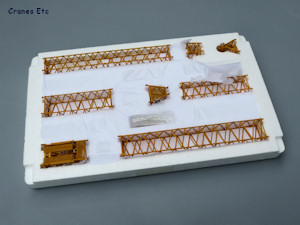 |
| Top tray
has the fixed jib. |
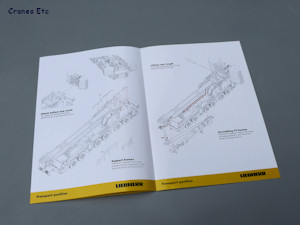 |
| Line
drawings in the manual.
|
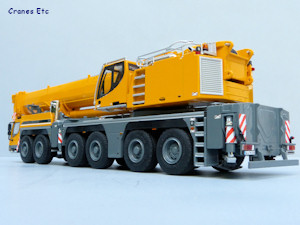 |
| Different
hubs on driven and non-driven axles. |
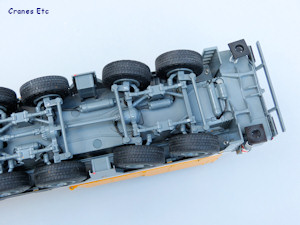 |
| Small tanks
and hoses. |
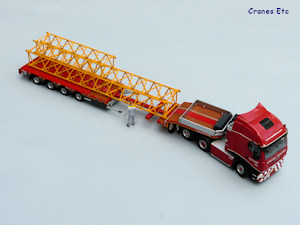 |
| Fixed jib
sections as a load. Smaller sections cannot be
loaded inside larger sections. |
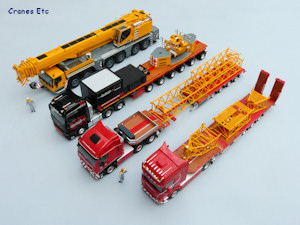 |
| Convoy
makes an interesting display. |
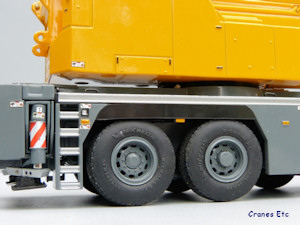 |
| Tyres have
sidewall mouldings with the Michelin name. |
 |
| Spreader
plates. |
|
|
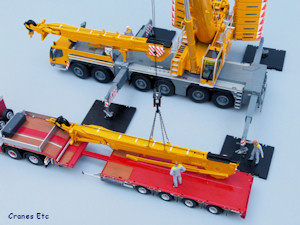 |
| Loading up
the Y-Guy frame. |
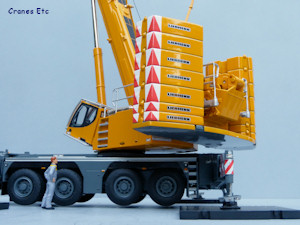 |
| Outriggers
can support the crane wheels-free. |
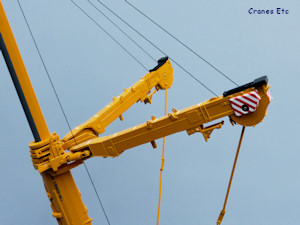 |
| Y-Guy
arrangement is detailed. |
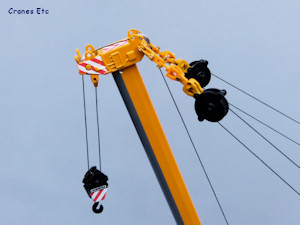 |
| Complex
boom head attachment for the Y-Guy. Colour match
of the plastic parts is not good. |
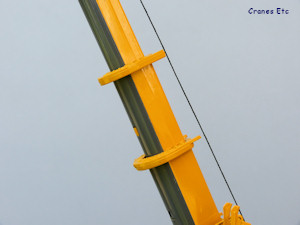 |
| Thin wall
boom sections. |
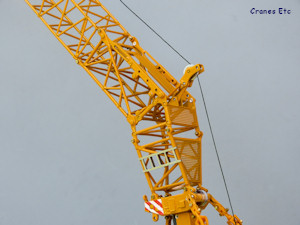 |
|
Angle adjustment on the boom. Mesh walkways. |
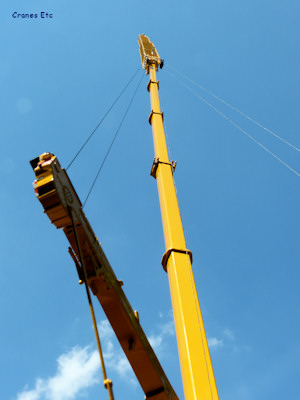 |
| Y-Guy
tensions up very well. |
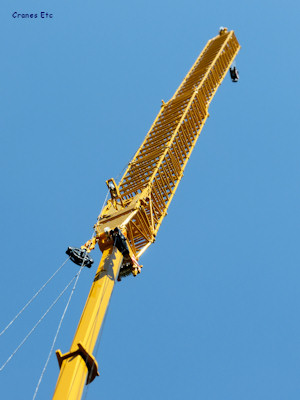 |
|
Looks real. |
|

